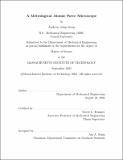| dc.contributor.advisor | David L. Trumper. | en_US |
| dc.contributor.author | Stein, Andrew John, 1978- | en_US |
| dc.contributor.other | Massachusetts Institute of Technology. Dept. of Mechanical Engineering. | en_US |
| dc.date.accessioned | 2005-05-19T15:09:32Z | |
| dc.date.available | 2005-05-19T15:09:32Z | |
| dc.date.copyright | 2002 | en_US |
| dc.date.issued | 2002 | en_US |
| dc.identifier.uri | http://hdl.handle.net/1721.1/16885 | |
| dc.description | Thesis (S.M.)--Massachusetts Institute of Technology, Dept. of Mechanical Engineering, 2002. | en_US |
| dc.description | Includes bibliographical references (p. 245-248). | en_US |
| dc.description | This electronic version was submitted by the student author. The certified thesis is available in the Institute Archives and Special Collections. | en_US |
| dc.description.abstract | This thesis describes the design, fabrication, and testing of a metrological atomic force microscope (AFM). This design serves as a prototype for a similar system that will later be integrated with the Sub-Atomic Measuring Machine (SAMM) under development in collaboration with the University of North Carolina at Charlotte. The microscope uses a piezoelectric tube scanner with a quartz tuning fork proximity sensor to image three-dimensional sample topographies. The probe position is measured with a set of capacitance sensors, aligned so as to minimize Abbe offset error, for direct measurement of probe tip displacements. A PC-based digital control system provides closed-loop control of the lateral scanning and axial height regulation actions of the probe assembly. The lateral scanning system, which dictates the probe's motion in directions parallel to the sample plane, has measured -3 dB closed-loop bandwidths of 189 Hz and 191 Hz in the X and Y directions, respectively. Meanwhile, the axial height regulator, which adjusts the length of the tube scanner to control for a constant gap between the probe tip and the sample surface, has demonstrated a -3 dB closed-loop bandwidth of as high as 184 Hz. The metrological AFM is operational and has been used to collect several images of sample surfaces. Images taken of a silicon calibration grating indicate that the microscope can easily resolve 100 nm-scale step changes in height. However, several errors are observed in the image data. Possible reasons for these errors are discussed, and ideas for follow-on work are suggested. | en_US |
| dc.description.statementofresponsibility | by Andrew John Stein. | en_US |
| dc.format.extent | 248 p. | en_US |
| dc.format.extent | 13220194 bytes | |
| dc.format.extent | 13219870 bytes | |
| dc.format.mimetype | application/pdf | |
| dc.format.mimetype | application/pdf | |
| dc.language.iso | eng | en_US |
| dc.publisher | Massachusetts Institute of Technology | en_US |
| dc.rights | M.I.T. theses are protected by copyright. They may be viewed from this source for any purpose, but reproduction or distribution in any format is prohibited without written permission. See provided URL for inquiries about permission. | en_US |
| dc.rights.uri | http://dspace.mit.edu/handle/1721.1/7582 | |
| dc.subject | Mechanical Engineering. | en_US |
| dc.title | A metrological atomic force microscope | en_US |
| dc.type | Thesis | en_US |
| dc.description.degree | S.M. | en_US |
| dc.contributor.department | Massachusetts Institute of Technology. Department of Mechanical Engineering | |
| dc.identifier.oclc | 51927798 | en_US |

